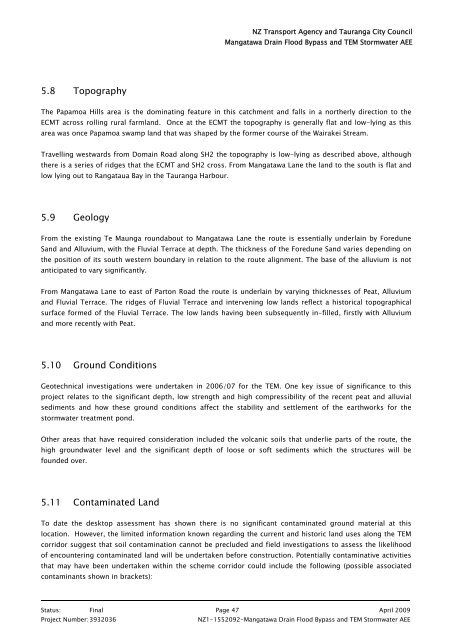2. Mangatawa catchment consents for earthworks, storm water ...
2. Mangatawa catchment consents for earthworks, storm water ...
2. Mangatawa catchment consents for earthworks, storm water ...
- No tags were found...
Create successful ePaper yourself
Turn your PDF publications into a flip-book with our unique Google optimized e-Paper software.
NZ Transport Agency and Tauranga City Council<br />
<strong>Mangatawa</strong> Drain Flood Bypass and TEM Storm<strong>water</strong> AEE<br />
5.8 Topography<br />
The Papamoa Hills area is the dominating feature in this <strong>catchment</strong> and falls in a northerly direction to the<br />
ECMT across rolling rural farmland. Once at the ECMT the topography is generally flat and low-lying as this<br />
area was once Papamoa swamp land that was shaped by the <strong>for</strong>mer course of the Wairakei Stream.<br />
Travelling westwards from Domain Road along SH2 the topography is low-lying as described above, although<br />
there is a series of ridges that the ECMT and SH2 cross. From <strong>Mangatawa</strong> Lane the land to the south is flat and<br />
low lying out to Rangataua Bay in the Tauranga Harbour.<br />
5.9 Geology<br />
From the existing Te Maunga roundabout to <strong>Mangatawa</strong> Lane the route is essentially underlain by Foredune<br />
Sand and Alluvium, with the Fluvial Terrace at depth. The thickness of the Foredune Sand varies depending on<br />
the position of its south western boundary in relation to the route alignment. The base of the alluvium is not<br />
anticipated to vary significantly.<br />
From <strong>Mangatawa</strong> Lane to east of Parton Road the route is underlain by varying thicknesses of Peat, Alluvium<br />
and Fluvial Terrace. The ridges of Fluvial Terrace and intervening low lands reflect a historical topographical<br />
surface <strong>for</strong>med of the Fluvial Terrace. The low lands having been subsequently in-filled, firstly with Alluvium<br />
and more recently with Peat.<br />
5.10 Ground Conditions<br />
Geotechnical investigations were undertaken in 2006/07 <strong>for</strong> the TEM. One key issue of significance to this<br />
project relates to the significant depth, low strength and high compressibility of the recent peat and alluvial<br />
sediments and how these ground conditions affect the stability and settlement of the <strong>earthworks</strong> <strong>for</strong> the<br />
<strong>storm</strong><strong>water</strong> treatment pond.<br />
Other areas that have required consideration included the volcanic soils that underlie parts of the route, the<br />
high ground<strong>water</strong> level and the significant depth of loose or soft sediments which the structures will be<br />
founded over.<br />
5.11 Contaminated Land<br />
To date the desktop assessment has shown there is no significant contaminated ground material at this<br />
location. However, the limited in<strong>for</strong>mation known regarding the current and historic land uses along the TEM<br />
corridor suggest that soil contamination cannot be precluded and field investigations to assess the likelihood<br />
of encountering contaminated land will be undertaken be<strong>for</strong>e construction. Potentially contaminative activities<br />
that may have been undertaken within the scheme corridor could include the following (possible associated<br />
contaminants shown in brackets):<br />
Status: Final Page 47 April 2009<br />
Project Number: 3932036<br />
NZ1-1552092-<strong>Mangatawa</strong> Drain Flood Bypass and TEM Storm<strong>water</strong> AEE
















